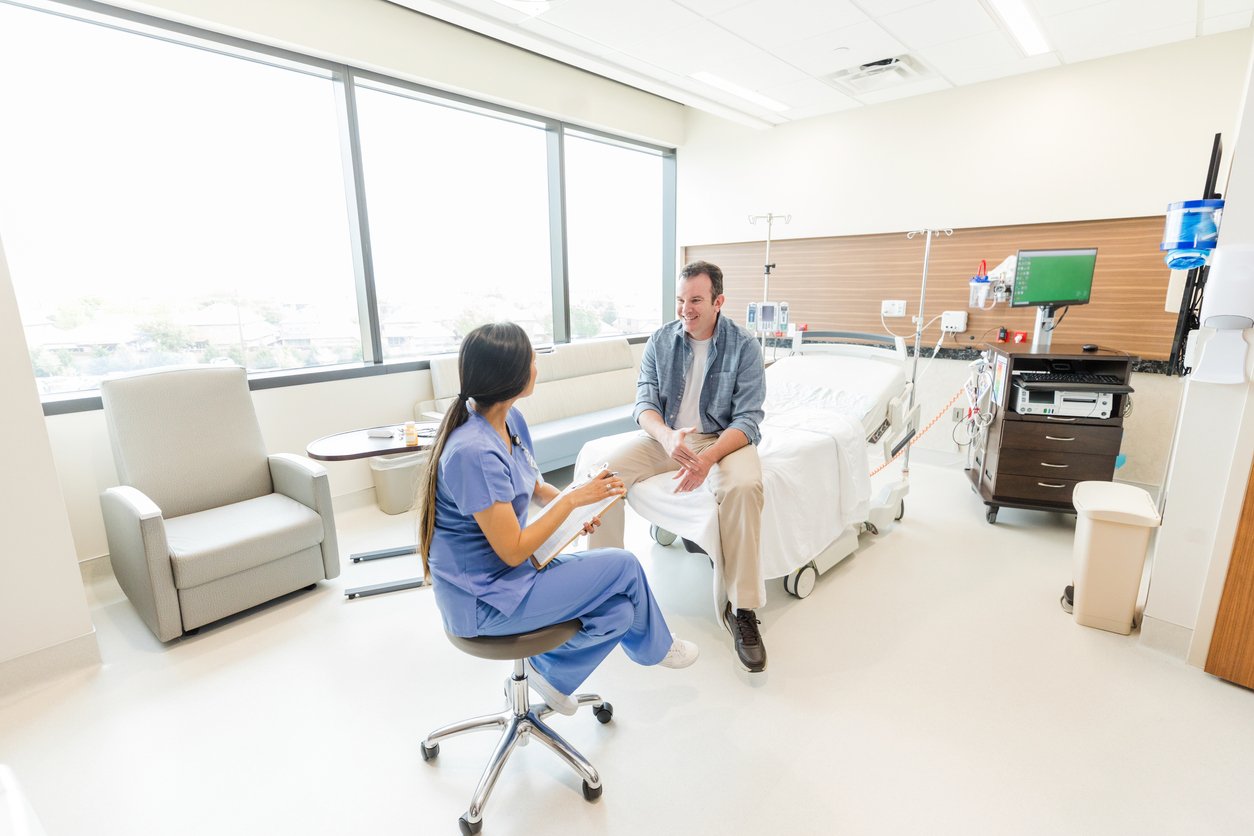Every piece of healthcare equipment in an acute care in-patient room has a distinct role in the care, recovery, and safety of the patient. Healthcare equipment included in hospital patient rooms and the adjacent bathroom helps ensure the needs of patients are met. From advanced vital signs monitoring systems and casework for personal items; to grab bars, each piece of equipment contributes to the standard of care. While in-patient rooms are not identical from hospital to hospital, there is equipment that is almost universally included in these rooms – think of this equipment as the starter kit.
This post will explore healthcare equipment commonly found in patient rooms and adjacent bathrooms.
Healthcare Equipment for Acute Care Patient Rooms
Diagnostic and Monitoring Devices
Diagnostic and monitoring devices in hospital patient rooms are essential for assessing and tracking a patient’s vitals in real time. In acute care settings, where timely interventions are critical, reliable diagnostic and monitoring equipment ensures that medical teams can respond quickly and effectively to changes in a patient’s condition.
Although not an exhaustive list, here are the devices commonly found in patient rooms:
Vital Signs Monitors:
Vital signs monitors are designed to continuously monitor basic vital signs, such as:

- Heart rate
- Blood pressure
- Temperature
- Oxygen saturation (SpO2)
Some models can also record ECG, ETCO2, SPO2, EMG, and IBP. These devices may be portable (spot monitors) or attached to the wall. Continuous vital signs monitors are frequently integrated into Electronic Health Records (EHR) to ensure the data is accurately recorded.
Wall Diagnostic Systems:
Wall diagnostic systems offer organized and easy access to diagnostic equipment. These systems include several of the components associated with vital signs monitors as well as other tools. These components are commonly included in wall diagnostic systems:
- Blood pressure cuff
- Ophthalmoscope
- Otoscope
- Pulse oximeter
- Spirometer
- Thermometer
Like vital signs monitors, wall diagnostic systems can be integrated with Electronic Medical Records (EMR) or Electronic Health Records (EHR).
Bed alarms
The primary function of bed alarms is to notify healthcare staff immediately when a patient moves or tries to leave the bed. With this notification, medical staff can intervene with assistance and preempt falls. Within acute care environments there are several types of bed alarms, they are:
- Mattress pad alarms: Placed under the bed sheet, these alarms detect pressure changes when the patient moves.
- Side rail alarms: Attached to the bed frame, these alarms are triggered when a patient attempts to get out of bed without assistance.
- Patient-worn alarms: These alarms are designed to be worn by the patient, detecting their movements and alerting staff.
Furniture and Casework
In hospital patient rooms, furniture, casework, and privacy curtains should be chosen with a focus on durability, functionality, and infection control. The following types of furniture and casework are commonly included in the patient rooms of acute care environments:
Hospital Beds: Beds used in hospitals are equipped with specialized features like pressure redistribution systems, adjustable height options, and safety features.
Bedside Tables: This piece of furniture is typically compact and easy to clean, often featuring drawers or shelves for storage of patient belongings.
 Overbed Tables: These adjustable tables can be moved over the patient's bed for meals, activities, or to support treatment equipment and supplies.
Overbed Tables: These adjustable tables can be moved over the patient's bed for meals, activities, or to support treatment equipment and supplies.
Patient Chairs/Recliners: Chairs for patients (or visitors) are designed to be easily cleaned and durable.
Wardrobes and Cabinets: Used for storing patient clothing, linens, and some healthcare supplies, this casework is often lockable for security.
Wall-Mounted Storage: Cabinets and shelves mounted on walls for easy access to healthcare equipment and supplies without taking up floor space.
Curtains: Ceiling-mounted curtains are used to create private enclosures for patients being treated in shared rooms.
Lighting
Although in some ways underappreciated, lighting is essential to patient care and comfort. The right lighting improves visibility for staff and can create a soothing atmosphere for patients.
- Task Lighting: This lighting offers adjustable intensity levels of focused illumination for examinations or other medical procedures performed in the patient room.
- Ambient Lighting: The comfortable and calming atmosphere created by ambient lighting is valuable for patients’ overall well-being as well as for helping to reduce the eye strain experienced by staff.
- Emergency Lighting: In the event of a power outage, battery powered backup lighting helps ensure staff can still attend to patient needs.
Essential Equipment For Patient Bathrooms
In many acute care settings, bathrooms are in the patient room. This adjacent space must include equipment designed for safety to help reduce the risk of falls and injuries. The following list is representative of the healthcare equipment installed in patient bathrooms.
- Grab Bars: Installed near toilets and showers to assist patients with mobility issues, wall mounted grab bars are constructed of high grade and easily cleanable stainless steel or aluminum alloy.
- Non-Slip Flooring: Water resistant flooring helps minimize the risk of falls in the bathroom.
- Emergency Call Buttons: Strategically placed and within easy reach, call buttons allow patients to call for assistance with minimal effort.
Safety Features to Look for in Healthcare Equipment
Healthcare equipment designed with safety features is essential for ensuring the well-being of patients, clinical staff, and visitors. These features are engineered to help prevent accidents, reduce the risk of infections, and improve overall patient care. As part of the evaluation of medical equipment for patient rooms, it is important to seek out safety features. The following top-level categories of safety features may be, in some respects, the most important for acute care healthcare professionals to look for.
- Infection control: Equipment should incorporate antimicrobial materials, be easy to clean and disinfect, and include features like seamless construction.
- Alarm Systems: Monitoring and treatment devices should be equipped with clear, reliable alarm/alert systems, particularly for essential equipment like patient monitors or infusion pumps.
- Fail-Safe Mechanisms: Devices should have built-in safety features to prevent malfunctions or errors, such as automatic shutoffs, backup power systems, and redundant components to ensure continuous operation in critical situations.
- Fall Prevention: Healthcare equipment like hospital beds and recliners should have anti-tipping features and available safety rails or supports.
How much Does a Standard Acute Care Hospital Room Cost?
The cost of fully equipping a patient room in a hospital can vary significantly depending on the level of care provided by the facility and the specific equipment needed. Here is a representative estimate of the costs involved:
A typical patient room in a hospital can cost between $250 to $450 per square foot to construct. This cost includes basic infrastructure but not all the necessary medical equipment.
The cost of standard medical equipment and furniture used in a patient room can vary widely based on the quality of the construction materials. The following costs offer a starting point:
- Hospital bed: $500 to $5,000
- Bedside table: $100 to $500
- Hospital-grade wardrobe: $500 – several thousand dollars
- Medical Recliners: $300 to $5,000 + depending on the features and quality of materials
- Vital signs monitor: Approximately $3,000
- Furniture (chairs, overbed tables): $1,000 to $3,000
These example costs together with the costs associated with contractor installed lighting, grab bars, ceiling mounted curtains, and call buttons suggest the total cost to fully equip a single patient room in a hospital could range from approximately $15,000 to $30,000, depending on the quality and sophistication of the equipment chosen.
It is important to note that this baseline estimate does not include shared equipment that might be used across multiple rooms, such as IV poles or glove dispensers and rubbish bins.
![]() Connect with a CME account manager to discuss the cost of healthcare equipment specific to the needs of your facility.
Connect with a CME account manager to discuss the cost of healthcare equipment specific to the needs of your facility.
Partner with CME for Patient Room Healthcare Equipment
As the United States’ largest equipment-only specialty distributor of equipment used in healthcare, we have built long term relationships with industry leading manufacturers.
Our expert account managers will work with you and the manufacturers’ representatives to help you equip patient rooms with healthcare equipment designed to help ensure safety, workflow efficiency, and high standards of care. Account managers with a focus on healthcare facility renovation and new construction projects can work with you and your construction teams to source contractor installed healthcare equipment like the ceiling mounted privacy curtains and casework.
Complementing CME’s expert focus on equipment used in healthcare are design and layout, project management, direct-to-site delivery, and biomedical services. We are the only medical equipment distributor nationwide, able to say we are truly a one-stop shop.
Direct-To-Site Logistics and Delivery Services
In addition to delivering healthcare equipment fully assembled when it is convenient for staff, CME Direct-to-Site services can off-set many of the person-hours associated with managing large orders by receiving, inspecting and warehousing the equipment for a single delivery. Our Direct-to-Site team will deliver healthcare equipment to the service location in the hospital and install equipment like wall-mounted diagnostic systems, so it is ready for immediate use.
Biomedical Services
Biomedical services have been at the heart of CME for over forty-five years. We are the only medical equipment distributor nationwide with an in-house team of biomedical technicians available to perform equipment check-in, asset tagging, asset validation preventive maintenance, and repair.
![]() Click the CHAT button to start a conversation about equipping patient rooms.
Click the CHAT button to start a conversation about equipping patient rooms.
______________________________________________________
FAQs
What is the most important equipment in an acute care patient room?
Patient monitors, hospital beds, and emergency call systems are among the most essential equipment in acute care rooms.
Why are grab bars necessary in patient bathrooms?
Grab bars help prevent falls and assist patients with mobility challenges, ensuring safety in the bathroom.
What are the benefits of adjustable hospital beds?
Adjustable hospital beds provide better comfort, support medical procedures, and enhance patient safety.
What features should be considered when selecting acute care equipment?
Safety, durability, infection control, and ease of use are key factors when selecting equipment for acute care settings.
About CME: CME Corp is the nation’s premier source for healthcare equipment, turnkey logistics, and biomedical services, representing 2 million+ products from more than 2,000 manufacturers. Headquartered in Rhode Island and with service centers coast to coast, our mission is to help healthcare facilities nationwide reduce the cost of the equipment they purchase, make their equipment specification, delivery, installation, and maintenance processes more efficient, and help them seamlessly launch, renovate and expand on schedule.



